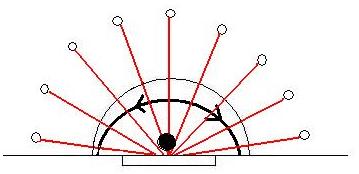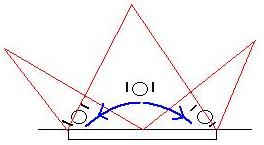As the ball moves around the pitch, more shooting lanes open up. As you face these different angles, you have to be able to move across with the ball; moving into cover the new angle, changing angles to suit the change in play and allow you to make the save against the new shot.
‘The D within the D’
To develop angle skills and a second sense of where you are in relation to the goal, you need to know where you are in the D. Imagining a smaller D within the actual D helps you locate your posts and position. This smaller D is the arc around goal; mirroring the D itself, but reduced for the size of angle of the shooter’s space. Depending on how deep you play within the D (how far you play off the line) and whether you like to step out and aggressively roam around, the size of this arc will change.
Imagine a D of 3 to 4 metres in diameter from the goal-line. The actual size will depend on your reaction speeds and your reach: if you have quicker reflexes, you can get away with playing a deeper style. The steps around the posts, getting from one side to the other will then create the D for you.

The arc
It is important to understand the arc of positioning: shots from the sides are different to front shots straight at you when standing centrally to the goal; stepping tight to the post covers a tight angle on the left or right space, but leaves a massive open space to the other side of you (that shooters can then exploit by passing to someone standing on that side), whereas with a central shot both sides are open to shoot at.
The arc goes from post to post, covering the different angles in relation to where the ball is on the pitch. As the ball moves, your position in the arc moves with it.

The border line for where you should be in terms of the goal, is as follows:
-
If the ball is central, you would be standing in the middle of goal; covering a straight shot down the middle and read to react to shots to the sides (which the shooter will try for as they can see the shooting space)
-
If the ball is to the left, you would step over to the left post to cover
-
If the ball is to the right, you would move to the right post to close off the space
Tip: If the ball moves to the goal line, then you would move to cover tight to the post itself (because you can close off the shot at the post, as there is no chance to shoot around you)
You should learn this arc and use it as a general guideline for positioning as the ball moves. Matching where you are to this in training practise and games, you will soon learn it so much that you know where you are automatically without having to look behind you (something only the best keepers can do by the ‘back of their hand’).
However, don’t think you have to move in this pattern all the time – if a pass is made and you have to change position, you need to move as quickly as possible, cutting across the arc to cover the open space.
Also remember that any given keeper’s arc will change as they gain size, strength and ability. You may want to run the exercise with the ropes once a season to see if their arc has changed
Adjusting your angles
Depending on which side the ball is on, you want to be able to move across to cover the post, or step with the play to close down the attacker and cover the shooting space available to them. By moving early, you can set up your triangle and angular positioning to help you in making the save you will face; closing down the shooter’s options to limit their chances of scoring.

By practising and practising, you should be able to learn how to read a shot: telling if it’s headed wide or at you. Knowing whether a shot will go wide or head to goal is essential to reach a high level of play; that way you know whether you will have to block a potential shot, or let it go wide and out of play.
For obvious writing reasons, I think Ian Taylor and Jeff Benjamin (www.jbgoalkeeping.com) should be accredited as sources, for their useful information in helping me write about this tricky subject of angles!